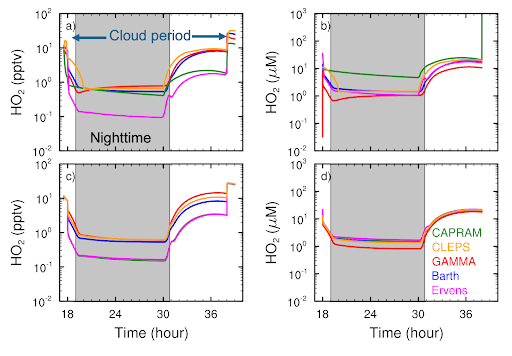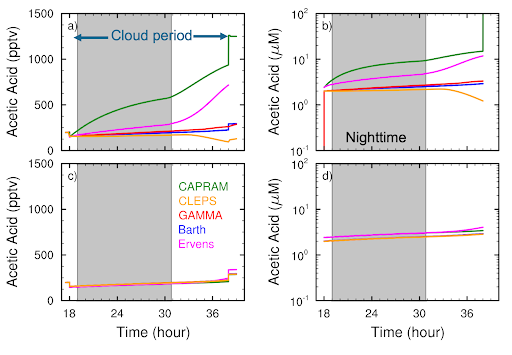Intercomparison of Box Models Simulating Cloud Chemistry
Chemical processes in clouds and fogs can substantially alter atmospheric oxidant budgets and lead to aerosol mass formation. To better predict air quality and climate processes, it is important to have an accurate description of cloud chemistry in regional-scale and global-scale chemical transport models. A comprehensive international box model intercomparison of cloud chemistry with physical and chemical observational constraints from mountain top sampling at Whiteface Mountain, New York was conducted to evaluate the current state of cloud chemistry knowledge. This study focused on oxidants and organic acid formation as the aqueous-phase chemistry of organics is not as well established as most inorganic aqueous-phase chemistry. Five models whose representation of gas and cloud chemistry ranged from simple schemes appropriate for 3-dimensional chemical transport models to highly complex schemes with thousands of reactions participated in the intercomparison.
The study highlights the need for the atmospheric chemistry community to provide recommendations of equilibrium and aqueous-phase reaction rate constants because differences among models could often be attributable to different effective Henry’s law constants. An example is shown in Figure 1 for the hydroperoxy radical HO2. A comparison of simulation results conducted by each modeling group to the simulation results where the chemistry mechanism was the same (Barth mechanism) but effective Henry’s law constants differed shows similar differences (except for the CAPRAM model), indicating that different effective Henry’s law constants caused different HO2 concentrations.

Organic acid production and loss depend strongly on OH radical concentrations, which are controlled by the chemical reactions. As a result of variability in OH concentrations among model predictions, organic acids like acetic acid (Figure 2) have substantial variability (top row) in both the gas and aqueous phases. By removing the influence of different chemical mechanisms, the acetic acid concentrations display similar predicted concentrations (bottom row). Thus, differences in the chemical mechanisms among models caused differences in OH radical and organic acids concentrations. These results show a need for developing effective simplified organic aqueous chemistry schemes.

Reference:
Barth, M. C., Ervens, B., Herrmann, H., Tilgner, A., McNeill, V. F., Tsui, W. G., Deguillaume, L., Chaumerliac, N., Carlton, A., and Lance, S. M., 2021: Box model intercomparison of cloud chemistry. J. Geophys. Res., 126, e2021JD035486. http://dx.doi.org/10.1029/2021JD035486